Connecticut is home to some of the most spectacular trees in the United States. From towering white pines in the state’s northeast corner to oak trees spanning an entire county, Connecticut’s trees tell a rich history of ecological and human activity. Whether you’re looking for a tree to climb or just seeking out some natural beauty, there are amazing trees all over Connecticut that are worth appreciating.
Do you want to make your Connecticut home more beautiful and improve the environment? Then planting trees native to the region is an excellent way to achieve that goal.
Connecticut is a state with diverse terrain and many different species of trees. Unfortunately, some of these species are becoming rare due to climate change, deforestation, and other environmental threats as the years pass. In order to preserve our local tree species and reforest areas where forests are depleting, it’s essential to focus on growing trees native to Connecticut.
This article will explore some of these incredible trees and the stories they tell about Connecticut’s history and culture.
1. Balsam Fir
A native of Connecticut, the balsam fir is an impressive evergreen with dense branches and fragrant needles. Balsam fir’s ability to withstand harsh winters, love of the sun, and low maintenance speak wonders for their easy-going growing habits. In addition, balsam fir is a loved Christmas tree in North America because of its pyramid shape and dark green needles.
Balsam fir can grow 40-60 feet tall and is a hardy species known for its ability to withstand cold temperatures and is drought-tolerant. It can also tolerate various soil types, from sandy to clay-based soils.
Another great reason to love and grow balsam fir in Connecticut is its attractive appearance. Its dark green needles are often more pointy than other conifers, and its narrow pyramidal shape can make it easy to fit into gardens and landscapes of any size. The needles also have a pleasant aroma that will fill your garden with a sweet scent.
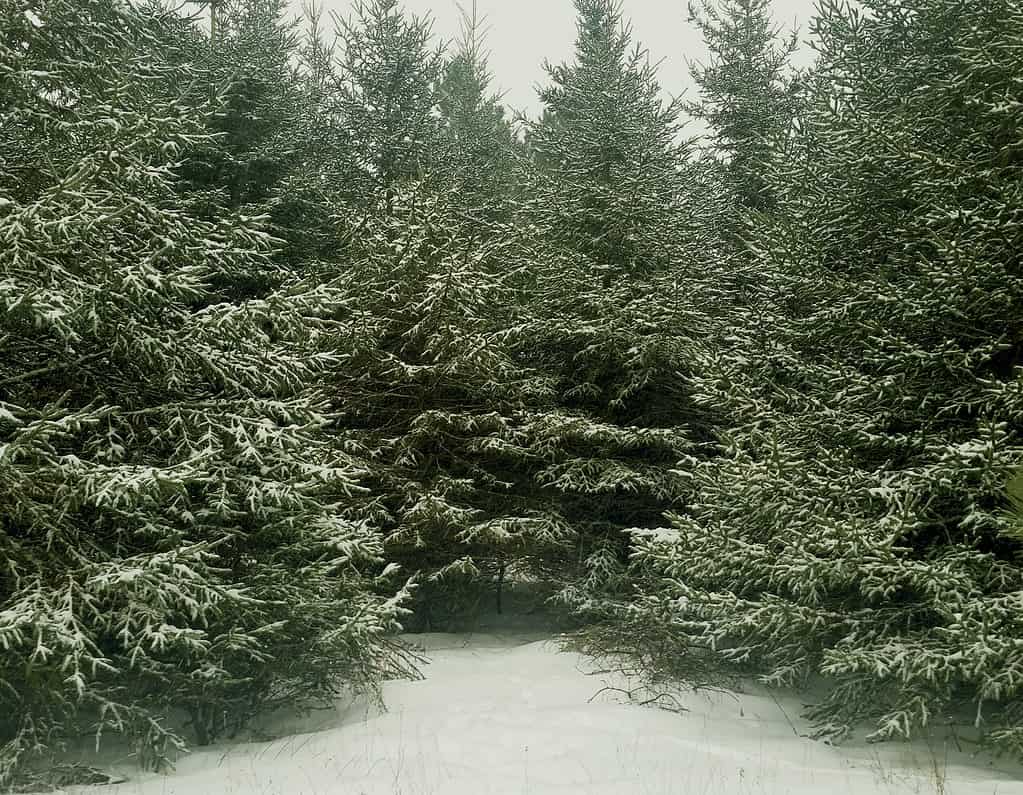
Balsam fir (pictured) is a loved Christmas tree in North America because of its pyramid shape and dark green needles.
©Sonia Horowitz/Shutterstock.com
2. Black Gum
The black gum tree (Nyssa sylvatica) is native to the eastern United States, Canada, and Mexico. Its natural range extends from Maine to Florida and west to Michigan and Iowa. In Connecticut, they can grow wild along rivers and in various forests, along with oak-pine, oak-hickory, northern hardwood, and other mixed wooded areas.
The black gum tree is an attractive addition to any landscape. Its bark is a dark gray-brown, and its leaves are glossy green in the summer, turning to shades of red and purple in the fall. This makes it an excellent choice for adding seasonal color to a landscape. They grow between 30-50 feet tall and 30 feet wide. Their roots grow deep into the soil, making it hard to move once they mature.
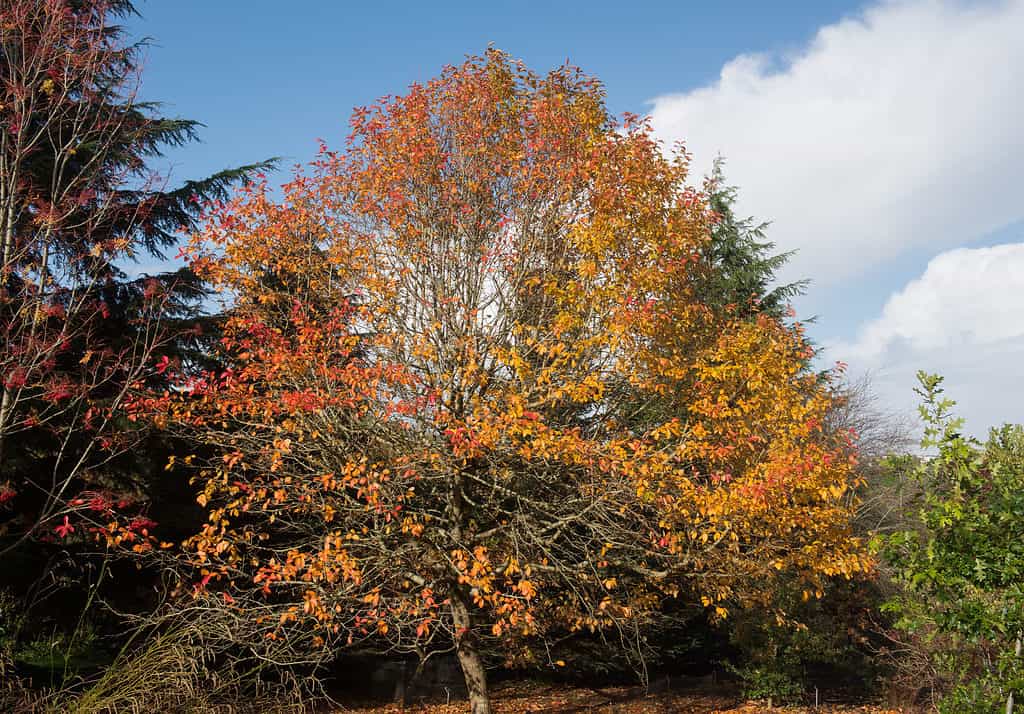
Black gum trees (pictured) have amazing fall colors, with beautiful shades of red, yellow, and orange.
©Peter Turner Photography/Shutterstock.com
3. Eastern Redcedar
Have you ever noticed the eastern redcedar tree in Connecticut, also referred to as Juniperus virginiana? Have you ever wondered why and how these trees have been growing for centuries in your state?
The eastern redcedar, a native coniferous tree to North America, has been a part of the landscape in most eastern states, including Connecticut, since pre-colonial times. In addition, this juniper species is often found in clusters near fields or along hedgerows throughout the northeastern United States and southeastern Canada.
The eastern redcedar is an easily recognizable tree in Connecticut’s diverse forests with its thick foliage and bushy branches. The eastern redcedar is a hardy species of juniper that can grow 50 feet tall and survive in various conditions for 150 years. It is tolerant of drought, heat, and cold temperatures, making it an ideal tree for Connecticut’s climate. In addition, the tree’s deep root system helps to stabilize the soil and prevent erosion.
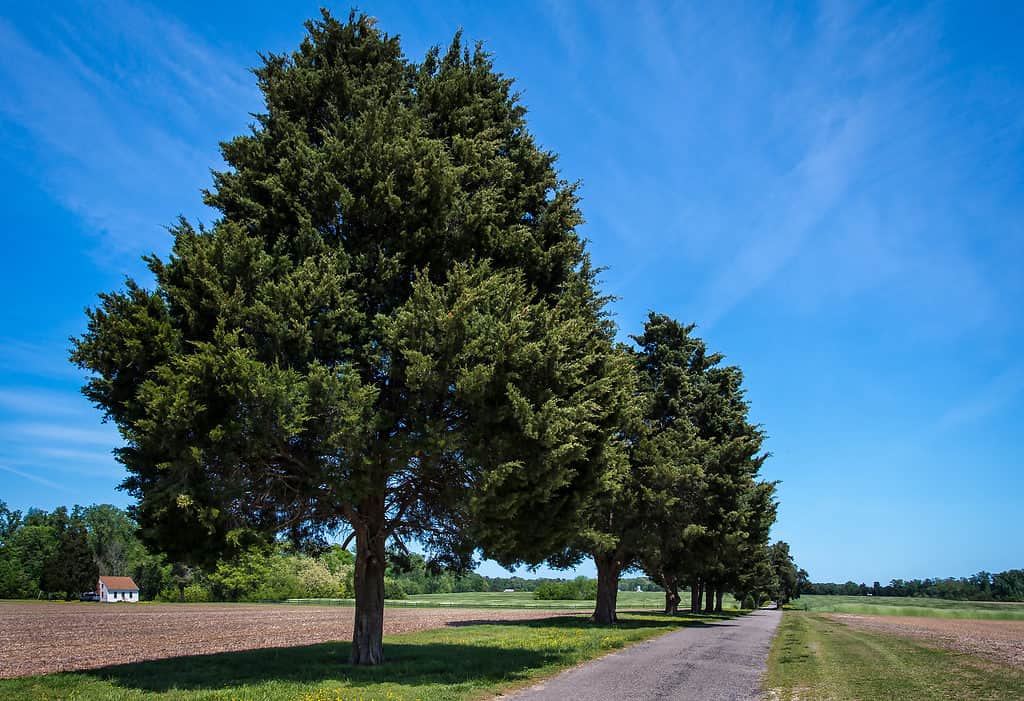
Eastern redcedar (pictured) can live 150 years under the right conditions.
©Gerry Bishop/Shutterstock.com
4. Red Mulberry
Native to Connecticut and other parts of the United States, the red mulberry tree (Morus rubra) is a stunning addition to any landscape. It adds colorful leaves, sweet fruits, and shade in the summer heat.
The red mulberry tree is a deciduous species that can reach heights up to 40 feet. Its leaves are dark green and have a glossy sheen. The bark of the tree is grayish-brown and has deep furrows. In the spring, small yellow or red flowers bloom on the branches, followed by clusters of sweet fruits in the summer months. These red and purple fruits are edible and used to make delicious jams and jellies.
The red mulberry tree is a hardy species that prefers full sun but can grow in partial shade. In addition, it is drought-tolerant and can withstand freezing temperatures. The red mulberry tree is an excellent addition to any landscape in Connecticut. Its unique characteristics make it an attractive choice for homeowners looking to create a natural oasis on their property.
Today, red mulberry trees are considered an endangered species in Canada due to the spread and crossbreeding of white mulberry, a non-native species.
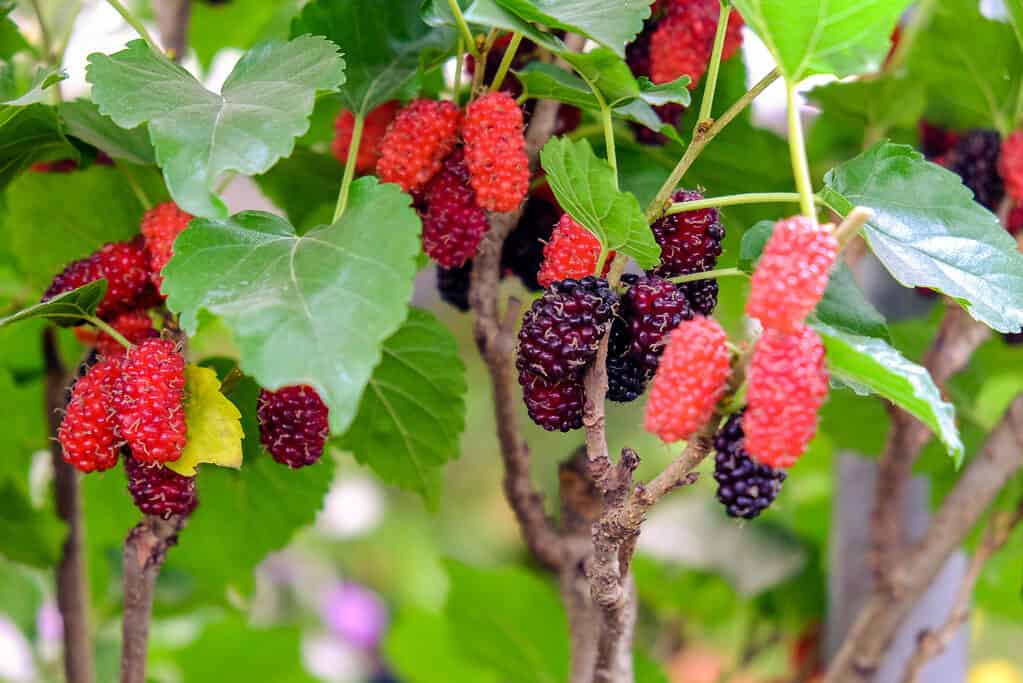
Red mulberry trees grow delicious edible red and purple fruit (pictured).
©Aunyaluck/Shutterstock.com
5. Red Maple
The red maple tree (Acer rubrum) is one of the most widespread trees in North America, reaching as far west as Manitoba, Canada, and as far south as Florida. It’s native to the area within Connecticut and grows naturally in lowland forests throughout New England.
Red maples have distinctive bright red leaves that stand out among other trees during autumn. The tree bark looks like strips of papery gray-brown when young and develops deep grooves when the tree matures. The red maples can reach 40 feet tall or more when fully grown and 40 feet wide. So if you’re looking for a colorful small tree or a full-sized shade tree, then maybe it’s time for a closer look at this native Connecticut species: the red maple tree!
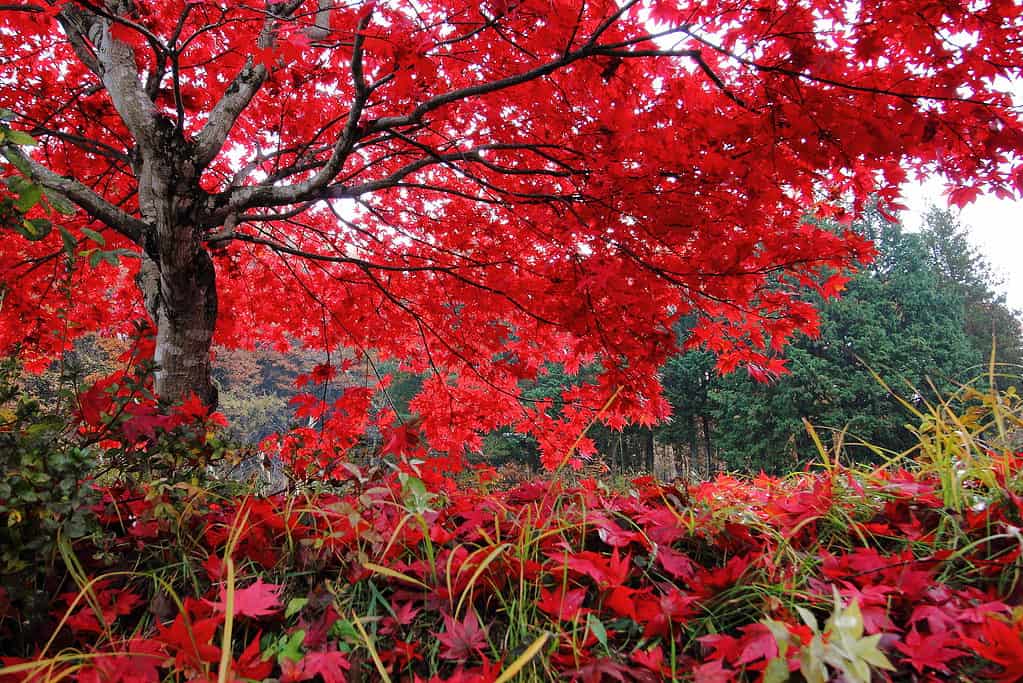
Red maple trees (pictured) have fiery-red leaves and brilliant appearance that will brighten any landscape.
©KungChuyada/Shutterstock.com
6. Eastern Redbud
The eastern redbud tree (Cercis canadensis) is native to the eastern United States and Canada. It grows in many parts of Connecticut, and you can find them along rivers, creeks, and woodlands. Redbud trees have an erect stem with a short trunk and branch out into several smaller stems, giving them a rounded look. In springtime, bright lavender-pink flowers bloom all over the plant before fading away, leaving behind heart-shaped leaves. The eastern redbud is both visually stunning and beneficial to the environment.
The eastern redbud is a deciduous tree that loses its leaves in the fall and grows them back in the spring. It typically grows about 20-30 feet tall and wide, with an average lifespan of around 25 years. The bark is grayish-brown and smooth when young but becomes more furrowed as it matures.
The flowers of the eastern redbud are one of its most distinctive features. They are a bright, purplish-pink color and bloom in clusters along the branches before the leaves appear. The flowers attract pollinators such as bees and butterflies, making them an important part of our ecosystem. They are also a valuable source of food for wildlife.
The eastern redbud is a beautiful addition to any landscape and can be easily cared for with minimal effort. It prefers full sun but can tolerate partial shade and does best in moist, well-drained soil. Pruning should get done in the late winter or early spring before the tree blooms.
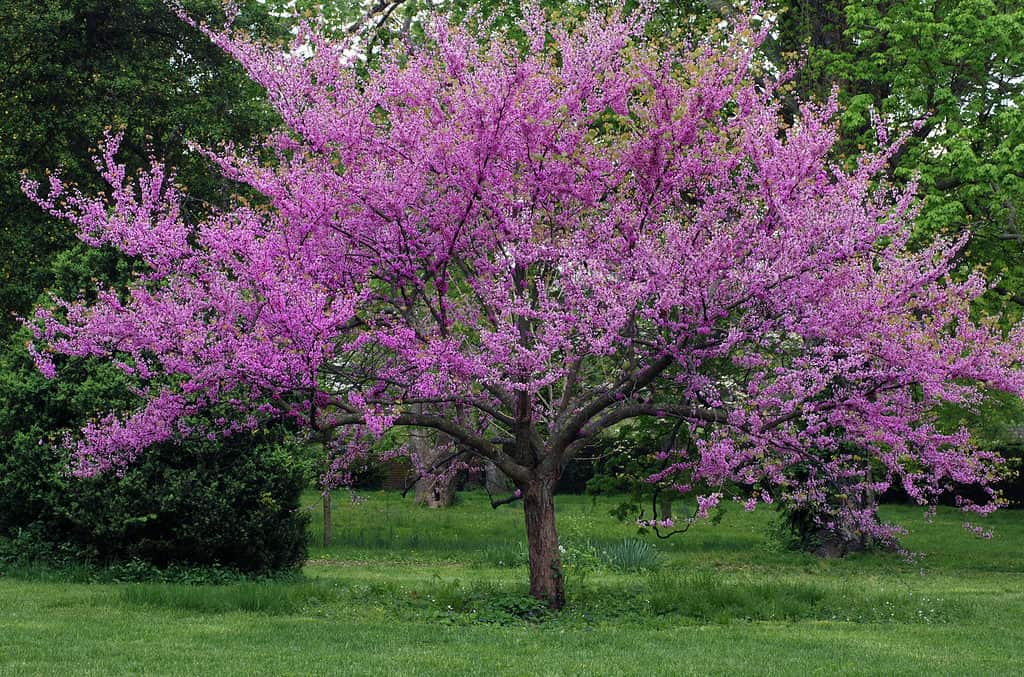
Eastern redbud trees (pictured) grow beautiful lavender-pink flowers and heart-shaped leaves.
©Marie C Fields/Shutterstock.com
7. White Oak
White oak (Quercus alba) trees are one of the most well-known trees in the state, lined along roads and shading neighborhoods throughout. Natives and visitors admire this iconic tree for their beautiful, dusty green leaves and recognizable bark texture.
White oak trees are native to Connecticut and can be found in many different habitats, from dry uplands to wet bottomlands. The leaves of white oaks are simple and alternate, with a lobed margin that is usually rounded or blunt at the end. The bark of these trees is grayish-brown and deeply furrowed.
White oaks are an important part of Connecticut’s forests and are long-lived trees, with some specimens living up to 500 years. If you’re looking for white oak trees in Connecticut, there are a few places to look. They are also popular for their wood, which is strong and durable. It gets used to make furniture, flooring, and other woodworking projects. White oak is also a favorite of winemakers, as its porous nature allows the wine to breathe while aging in barrels.
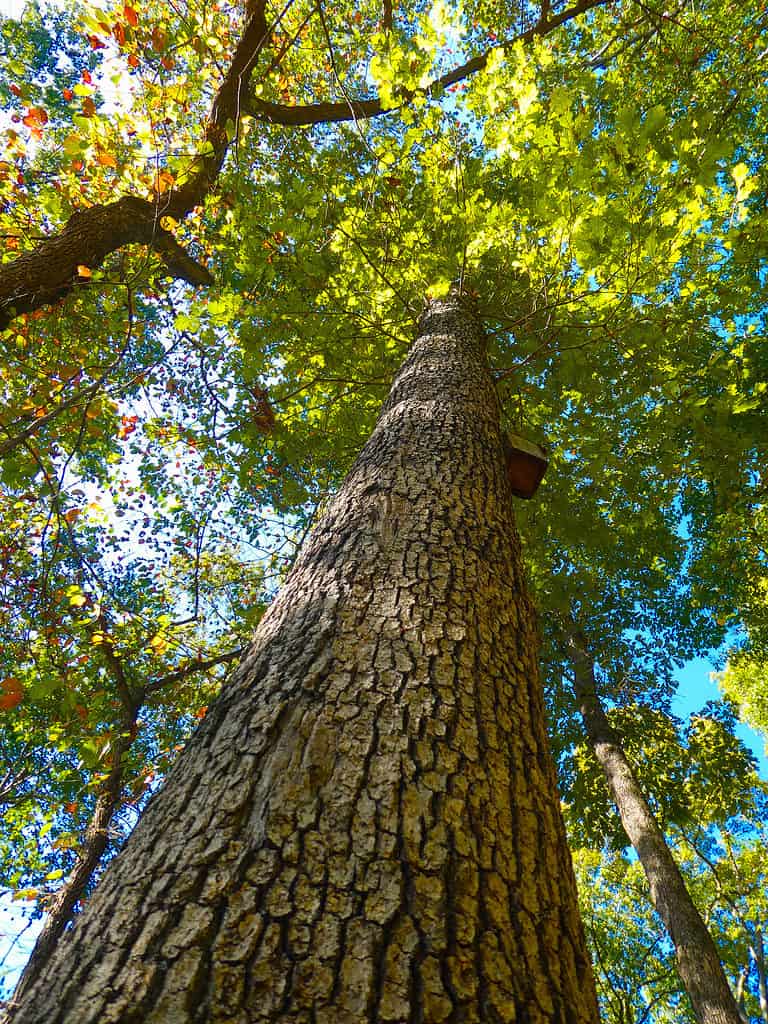
White oak trees (pictured) get their name from the white color found on newly cut wood.
©ForestSeasons/Shutterstock.com
The photo featured at the top of this post is © Enfi/Shutterstock.com
FAQs (Frequently Asked Questions)
What is the most common tree in Connecticut?
More than 60% of Connecticut is covered by forests, with 51% oak-hickory hardwood.
What is the state tree of Connecticut?
The official Connecticut state tree is Charter Oak.
Where is Connecticut's largest tree?
The largest tree in Connecticut can be found in Simsbury in the northwest. The American sycamore is over 100 feet tall and between 200-300 years old.
Thank you for reading! Have some feedback for us? Contact the AZ Animals editorial team.






